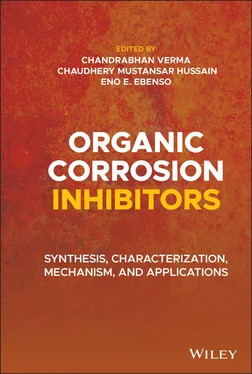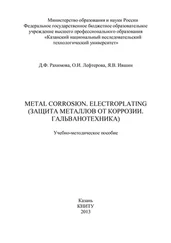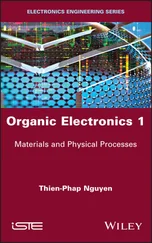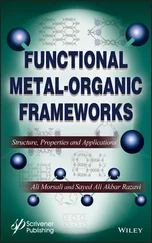3.2.1 Theoretical Framework
The basis of DFT was introduced in1964 by Hohenberg and Kohn as a result of two theorems elegantly demonstrated in [20, 21]. According to these theorems, Hohenberg and Kohn stated that the ground state of a fully interacting system with N electrons is a unique functional of the electronic density 𝜌(r). So, DFT is a formulation in terms of functional of the density.
For DFT‐based simulation, the general expression may then be written as [22]:
(3.1) 
In the above equation, T sdenotes the kinetic energy functional ( S indicates that the kinetic energy is obtained from a Slater determinant), E neand J are the functionals for electron–nuclear attraction and the Coulomb part of the electron–electron repulsion, respectively. E xcis the functional for the exchange correlation. It is important to note that each of these terms is related to electron density.
Of course, the abovementioned theorems were followed by the important work proposed by Kohn and Sham [23], which represented an approximation to define the exchange‐correlation energy functional for the DFT method. It can be noted that the exchange‐correlation energy functional remains a poorly defined term in the proposed system and is not known. So, the work published by Kohn and Sham (K‐S) became the paradigm for solving the problem by replacement of the exchange potential term by a more general exchange‐correlation potential. For that, K‐S introduced orbitals, also called KS orbitals. As suggested by K‐S, the electron density is represented by an auxiliary set of orbitals in which we can determine the electron kinetic energy. In fact, an electronic system simulated with the aid of K‐S model‐based DFT method is closely linked to the well‐known Hartree–Fock (HF) method. In this frame, the formulas used for calculation of kinetic, electron–nuclear, and Coulomb electron–electron energies are identical for both methods.
Concerning the basic functionals used for the description of DFT‐based simulations, it has been resulted that DFT can be broken down into many of functional classes. The simplest model is the local density approximation (LDA), which was introduced in 1951 by Slater [24]. In this case, DFT within LDA includes only electron exchange without the correlation. Up to now, LDA was very successful in describing electronic systems and there are similarities between the results expressed by LDA and those described by HF. In the 1980s, the generalized gradient approximations (GGAs) were introduced in order to go beyond a few systematic errors obtained by LDA like overestimations of molecular atomization energies and bond lengths. The prominent idea of GGAs makes use of the spin densities and the spatial variation of the exchange‐correlation energy, i.e. the latter taking into account both the density and its gradients. In addition, B3LYP functional was fully proposed and identified in 1998 and it is one of the most popular hybrid functional. In 1994, B3LYP was already been used successfully for the first time in the Gaussian package and it is most successful in terms of overall performance. B3LYP model can be described via the following equation [25]:
(3.2) 
Herein,  represents exchange energy computed with KS orbitals on the basis of HF theoretical level,
represents exchange energy computed with KS orbitals on the basis of HF theoretical level,  means the local exchange energy,
means the local exchange energy,  denotes the gradient corrections to the exchange energy, and
denotes the gradient corrections to the exchange energy, and  represents the gradient corrections for the correlation energy constructed by Lee, Yang, and Parr (LYP) [26].
represents the gradient corrections for the correlation energy constructed by Lee, Yang, and Parr (LYP) [26].
Another potential problem for computational chemists is how to choose the basis set to express the unknown molecular orbitals in terms of a set of known functions. However, what is not yet understood is the relative importance of any type of basis functions used for representing the electronic wave function. What is important for us to recognize here is that the molecular wave functions can be expressed as the linear combination of atomic orbitals (LCAO).
In principle, many electron systems can be optimized and practically verified using many types of basis functions such as exponential, Gaussian, polynomial, cube functions, wavelets, plane waves, etc. Nevertheless, it is necessary here to note that Gaussian functions are computationally much easier to handle. In the DFT method, STO‐3G is a minimal and a simplest basis set that can be used. Briefly, much of the literature [25, 27–31] emphasizes the description of basis sets in the HF and DFT methods, which suggests that increasing the size of the basis set allows a better description of the KS orbitals. For example, 3–21G, 6–31G, 6–311G, and LanL2DZ basis sets are much more likely to be useful in the DFT method for good improvement of QC calculations.
3.2.2 Theoretical Application of DFT in Corrosion Inhibition Studies: Design and Chemical Reactivity Prediction of Inhibitors
As mentioned earlier, DFT‐based simulations are widely used in the field of corrosion inhibition to discuss the electronic properties of organic compounds and help in describing the characteristics of inhibitor/surface interactions, which can advance our knowledge about the corrosion inhibition mechanism in its relationship with the structural nature of molecules. In this respect, a variety of QC descriptors such as highest occupied (HO) and lowest unoccupied (LU) molecular orbitals (MO), frontier orbital energies, energy band gap, hardness, electronegativity, Mulliken and Fukui population analyses, electron‐donating power, electron‐accepting power, chemical potential, hardness, softness, dipole moment and number of electrons transferred, etc., are described and used in the prediction of the characteristic of molecules in terms of chemical reactivity and binding affinities.
On the basis of the DFT method, the results were obtained for all chemical parameters indicated previously at different levels of theory with the aid of reliable open source and commercial software. Within this framework, here, we describe briefly some of the chemical parameters and their mathematical formulas that are the most used in corrosion inhibition studies. More detailed information about all QC descriptors, and their applications for elucidating and understanding the properties of molecules is presented in the literature [25, 32, 33].
3.2.2.1 HOMO and LUMO Electron Densities
It is well known that HOMO and LUMO distributions (also called FMOs) in a corrosion inhibitor molecule are quite important tools in predicting the chemical reactivities of molecules. These tools are considered for identifying the adsorption points of the molecules which is liable for the interaction with the metal surfaces. As a definition, in an inhibitor molecule, HOMO density is associated with the affinity of electron donation, while LUMO density is related with inclination to receipt an electron. The presence of a wide range of heteroatoms and functional groups in an inhibitor molecule is mainly associated with a higher HOMO density and therefore a higher electron‐donating property.
Читать дальше



 represents exchange energy computed with KS orbitals on the basis of HF theoretical level,
represents exchange energy computed with KS orbitals on the basis of HF theoretical level,  means the local exchange energy,
means the local exchange energy,  denotes the gradient corrections to the exchange energy, and
denotes the gradient corrections to the exchange energy, and  represents the gradient corrections for the correlation energy constructed by Lee, Yang, and Parr (LYP) [26].
represents the gradient corrections for the correlation energy constructed by Lee, Yang, and Parr (LYP) [26].










